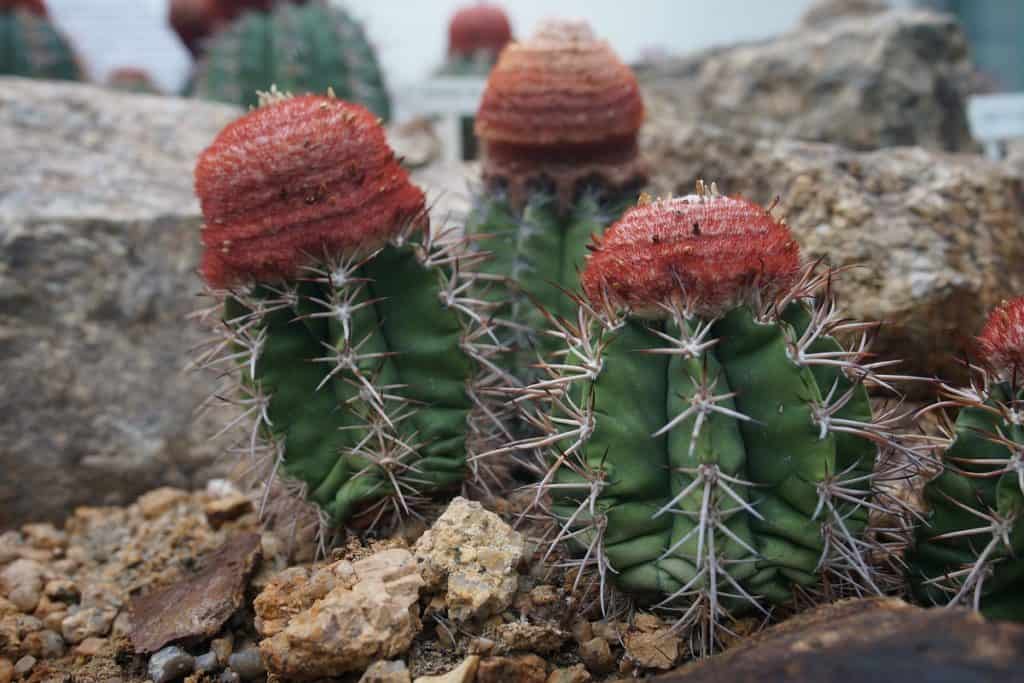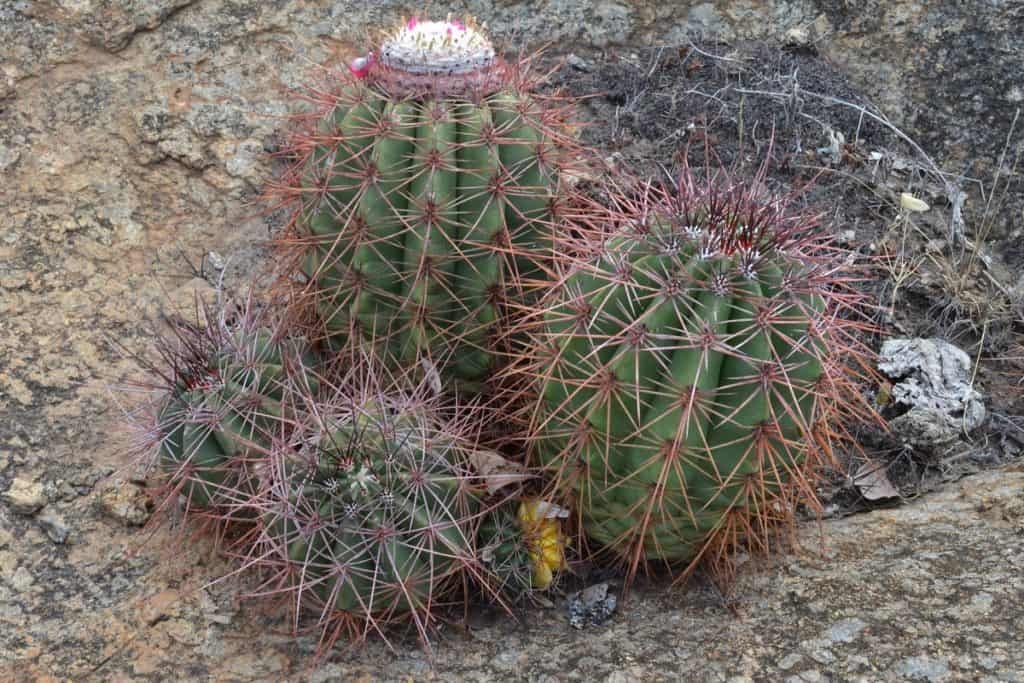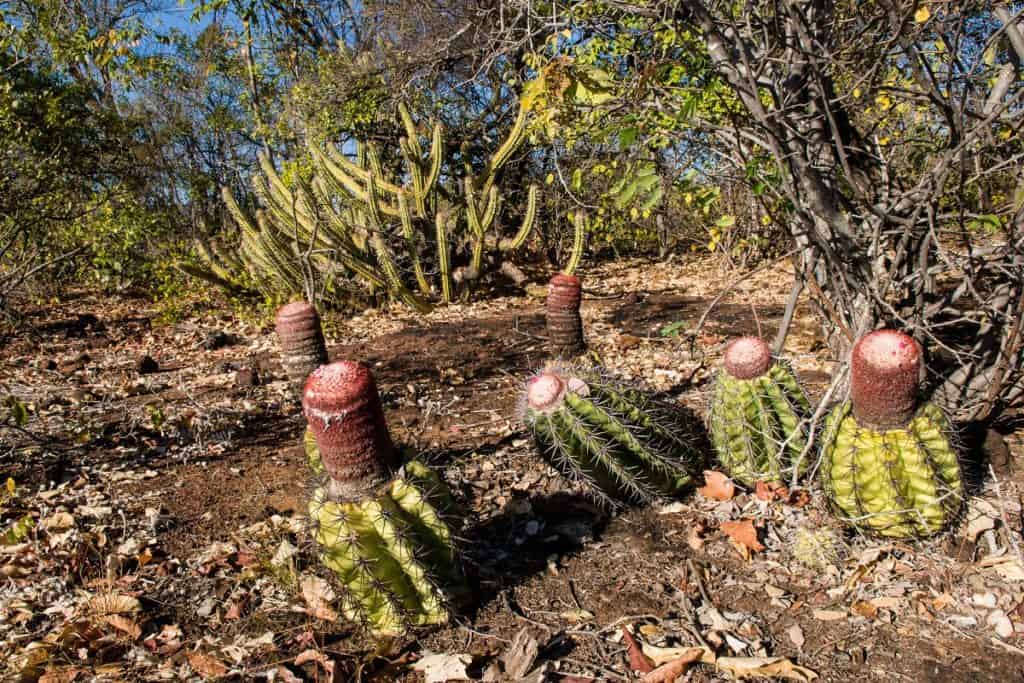Melocactus deinacanthus: Characteristics and Care
Get ready to meet a real showstopper in the cactus world – the one and only Melocactus deinacanthus! This prickly beauty is about to rock your socks off with its bizarre looks and quirky features. Trust me, you’ve never seen a cactus quite like this before!

Contents
About Melocactus deinacanthus
This stunner is native to Brazil, where it thrives in rocky, coarse regions. At first glance, it looks like your average barrel cactus – nothing too out of the ordinary. But wait till you see its crazy cephalium (that’s cactus lingo for the woolly white cap on top)!
The cephalium can grow up to 10 inches tall and 3.5 inches wide. Unlike typical reddish bristles, this one stays bright white with just a few reddish-brown spines poking through the fuzzy fibers. Weird, right?
The stem is pretty chunky too, reaching around 14 inches tall and 10 inches wide when fully grown. It’s rounded or cylinder-shaped with 10-12 sharp ribs armed with 4-7 central spines up to 2 inches long and 11-14 radial spines up to 3 inches long. Now that’s one mean cactus!
But the weirdness doesn’t stop there. Come late summer, stunning pink-magenta flowers up to 1 inch long bloom from the cephalium. It’s a showstopper, I tell ya!
Related Post:
35 Types of Melocactus Cacti [With Pictures]
How to Care for Melocactus deinacanthus
These divas aren’t the easiest to please, so newbies beware. But with some extra TLC, you can tame this wild child. Here’s the 411:
Light
The Melocactus craves tons of bright, direct sunshine to really thrive. Aim to give it at least 6 hours of unobstructed sun rays per day. A sunny south or west facing window is perfect for indoor plants. Or you can set it outside during summer! If neither option works, supplement with a strong grow light and keep it just a few inches away for 12-14 hours per day.
Water
This cactus has a bigger thirst than most! It needs more frequent watering, about once every 7-10 days during its growing season from April to October. The key is to let the soil dry out just a little between waterings, but not completely. Stick your finger down into the soil and when the top inch or two is just barely dry, it’s time to thoroughly soak it again. In winter when growth slows, you can cut back to watering once a month.

Soil
A fast-draining cactus/succulent soil mix is an absolute must to prevent rot. Buy a premixed blend or make your own by combining 1 part regular potting mix with 1 part coarse sand or perlite. You can even add in some chicken grit or pebbles for extra drainage. Just avoid moisture-retaining ingredients.
Fertilizer
To keep this cactus plump and perky, feed it a proper cactus fertilizer every 4-6 weeks during its growing period. Look for a balanced 10-10-10 or 8-8-8 fertilizer made for cacti and succulents. Always dilute it to half strength when applying to prevent burning the roots. No need to fertilize in winter when it’s resting.
Temperature and Humidity
This heat-loving cactus demands warm and toasty conditions to truly flourish. It needs consistent temperatures above 65°F at all times, ideally in the 70s during the day. Any cold drafts or temperatures below 60°F can severely damage or even kill it.
As for humidity, the Melocactus deinacanthus prefers humidity on the higher side around 50-60%. While it can tolerate typical household humidity of 40%, increased humidity will promote faster, lusher growth. Use a humidity tray or room humidifier if your indoor air is too dry.
Pests & Problems
Like most cacti, the Melocactus can fall victim to common critters like mealybugs, spider mites, and fungus gnats. The biggest threat though is root rot from overwatering or poor drainage. Avoid wetting the cephalium crown too, as it can cause rot. Cold drafts can also damage this heat-lover.
Pruning
No need to prune back that wild and woolly cephalium! The only pruning required is to snip off any dead, damaged or discolored stems as needed using clean shears.
Potting & Repotting
The Melocactus actually prefers being underpotted and rootbound to a degree. So don’t go too big when repotting! An unglazed ceramic pot with drainage holes 1-2″ wider than the current pot is ideal. Really pack that fresh cactus soil in firmly.

How to Propagate Melocactus deinacanthus
The only way to propagate the unique Melocactus deinacanthus is from seeds. It’s a fun process to try your hand at! Here are the steps:
- Obtain fresh Melocactus deinacanthus seeds from a reputable source
- Fill a shallow tray or pot with a well-draining cactus/succulent seed starting mix
- Sow the seeds by pressing them 1/4 inch into the soil, spacing them 1-2 inches apart
- Cover the tray with a clear plastic lid or wrap to greenhouse it
- Place the covered tray in a warm spot around 70-75°F
- Keep the soil lightly moist but not soggy while awaiting germination in 1-3 months
- Once sprouted, remove the cover and move seedlings to a sunny spot or under a grow light
- Allow the soil to dry out slightly between waterings
- When a few inches tall, transplant seedlings into their own small pots
- Be patient – it can take 3-4 years for a Melocactus to grow its signature cephalium!
With their exotic capped looks and stubborn growing nature, Melocactus deinacanthus can be a challenge to propagate from seed. But it’s such a rewarding process to grow these quirky cacti yourself!
